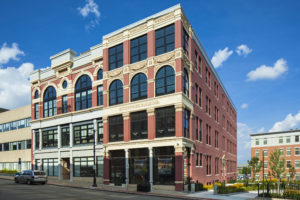By Kenan Bigby, Managing Director
Mixed-income housing has been a growing trend in real estate over the past decade, spurred both by community needs and by developers looking to distinguish their projects from the field. But the process of building mixed-income developments is not as straight forward as sprinkling affordable units into a new market-rate development. These types of projects are complicated requiring complex financial structuring, careful planning and strategic location selection. So why do it? Last winter, I spoke on a panel at ABX 2016 where I was joined by Angie Liou, Executive Director of Asian Community Development Corporation and Andre Leroux Executive Director – Massachusetts Smart Growth Alliance.
During the panel, I shared insights about our Enterprise Center development in Brockton, MA, discussing the challenges and importance of building mixed-income housing in smart locations.
When Trinity Financial first looked at Brockton, MA as a location to invest in, the city was at the beginning of its renaissance. While market conditions were not yet strong enough to support a fully market-rate development downtown, elected officials and stakeholders expressed a need for more market-rate housing, fearing that exclusively developing affordable units would prevent the type of economic development necessary to spur Brockton’s emerging downtown.
 So what made us decide that Brockton would be a smart site to develop mixed-income housing? Brockton had two of the most important ingredients – the right physical location, and dedicated and involved stakeholders. First, the Enterprise Center is transit-oriented, located within close proximity to the MBTA Commuter Rail system as well as the Brockton Area Transit bus system, ensuring residents will be well-connected to the surrounding community. Because of the existing infrastructure in downtown Brockton, we were confident that the city would be able to accommodate the new development, physically and economically. But ensuring that the project would come to fruition required a strong coalition, including Brockton stakeholders such as: local elected officials, municipal employees, members of the downtown business community and of course, the Trinity team , aligning with a shared mission to benefit the Brockton community at large. With the right location and team, we were able to transform a parcel of land that generated no revenue into a fully taxable property, providing an economic stimulus through development that will help revitalize Brockton. A rising tide floats all boats and as downtown Brockton strengthens, it will continue to encourage more development, making Brockton a smart city for future mixed-income and mixed-use developments.
So what made us decide that Brockton would be a smart site to develop mixed-income housing? Brockton had two of the most important ingredients – the right physical location, and dedicated and involved stakeholders. First, the Enterprise Center is transit-oriented, located within close proximity to the MBTA Commuter Rail system as well as the Brockton Area Transit bus system, ensuring residents will be well-connected to the surrounding community. Because of the existing infrastructure in downtown Brockton, we were confident that the city would be able to accommodate the new development, physically and economically. But ensuring that the project would come to fruition required a strong coalition, including Brockton stakeholders such as: local elected officials, municipal employees, members of the downtown business community and of course, the Trinity team , aligning with a shared mission to benefit the Brockton community at large. With the right location and team, we were able to transform a parcel of land that generated no revenue into a fully taxable property, providing an economic stimulus through development that will help revitalize Brockton. A rising tide floats all boats and as downtown Brockton strengthens, it will continue to encourage more development, making Brockton a smart city for future mixed-income and mixed-use developments.
In 2015, we completed Phase 1 of the Enterprise Center, creating 113 total housing units, including 42 market rate, 29 affordable and 42 artist preference units. Along with 52,000 square feet of commercial/office space, 10,000 square feet of retail and artist exhibition space, 95 residential parking garage spaces and 185 surface parking lot spaces, the Enterprise Center is now a successful development that Trinity Financial is proud to have as a part of our portfolio. But that’s not all – we are looking forward to beginning Phase 2 later this year!
For more information on Enterprise Center click here. For more information on Trinity Financial visit our website or follow us on Twitter at @Trinity_RE.
